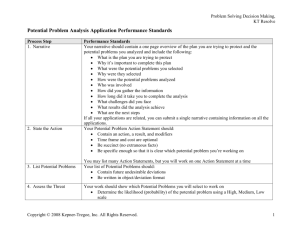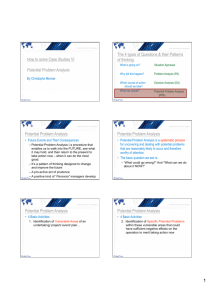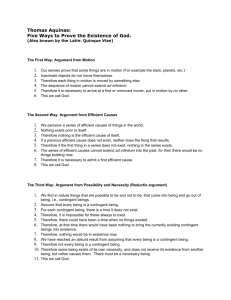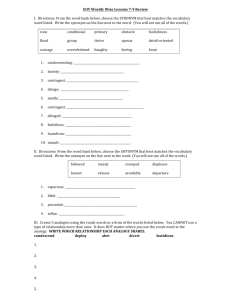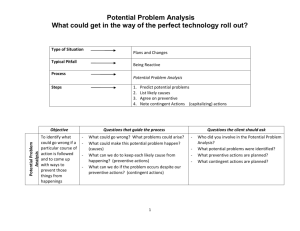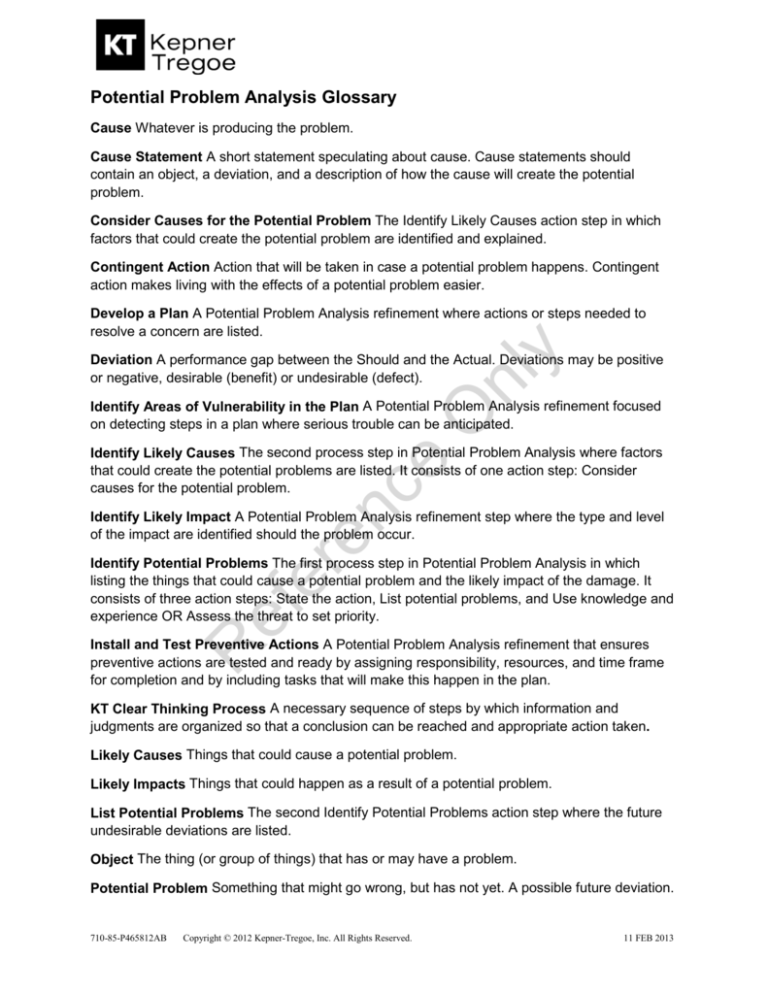
Potential Problem Analysis Glossary
Cause Whatever is producing the problem.
Cause Statement A short statement speculating about cause. Cause statements should
contain an object, a deviation, and a description of how the cause will create the potential
problem.
Consider Causes for the Potential Problem The Identify Likely Causes action step in which
factors that could create the potential problem are identified and explained.
Contingent Action Action that will be taken in case a potential problem happens. Contingent
action makes living with the effects of a potential problem easier.
y
Develop a Plan A Potential Problem Analysis refinement where actions or steps needed to
resolve a concern are listed.
nl
Deviation A performance gap between the Should and the Actual. Deviations may be positive
or negative, desirable (benefit) or undesirable (defect).
O
Identify Areas of Vulnerability in the Plan A Potential Problem Analysis refinement focused
on detecting steps in a plan where serious trouble can be anticipated.
en
ce
Identify Likely Causes The second process step in Potential Problem Analysis where factors
that could create the potential problems are listed. It consists of one action step: Consider
causes for the potential problem.
Identify Likely Impact A Potential Problem Analysis refinement step where the type and level
of the impact are identified should the problem occur.
ef
er
Identify Potential Problems The first process step in Potential Problem Analysis in which
listing the things that could cause a potential problem and the likely impact of the damage. It
consists of three action steps: State the action, List potential problems, and Use knowledge and
experience OR Assess the threat to set priority.
R
Install and Test Preventive Actions A Potential Problem Analysis refinement that ensures
preventive actions are tested and ready by assigning responsibility, resources, and time frame
for completion and by including tasks that will make this happen in the plan.
KT Clear Thinking Process A necessary sequence of steps by which information and
judgments are organized so that a conclusion can be reached and appropriate action taken.
Likely Causes Things that could cause a potential problem.
Likely Impacts Things that could happen as a result of a potential problem.
List Potential Problems The second Identify Potential Problems action step where the future
undesirable deviations are listed.
Object The thing (or group of things) that has or may have a problem.
Potential Problem Something that might go wrong, but has not yet. A possible future deviation.
710-85-P465812AB
Copyright © 2012 Kepner-Tregoe, Inc. All Rights Reserved.
11 FEB 2013
Potential Problem Analysis A rational process for protecting the success of actions or plans. It
consists of four process steps: Identify Potential Problems, Identify Likely Causes, Take
Preventive Actions, Prepare Contingent Actions and Triggers.
Prepare Actions to Reduce Likely Impact The Prepare Contingent Actions and Triggers
action step in which ways to minimize the impact of the potential problem are determined.
Prepare and Test Contingent Actions and Triggers A Potential Problem Analysis refinement
where specific contingent actions and triggers are put in place by assigning responsibility,
resources, and time frame for completion.
Prepare Contingent Actions and Triggers The final Potential Problem Analysis process step.
Preparing actions that will reduce the effects of the potential problem. It consists of two action
steps: Prepare actions to reduce likely impact and Set triggers for contingent actions.
y
Preventive Action Action you take to reduce the likelihood of a potential problem occurring.
nl
Process A systematic set of steps to meet a goal.
O
Question to the Void A questioning technique where follow-up questions are asked until you
get the most specific information.
ce
Set Priority Choosing which potential problems to work on first based on their probability and
seriousness profile. Priority can be set by using one of two action steps: Use knowledge and
experience or Assess the threat.
en
Set Triggers for Contingent Actions The Prepare Contingent Actions and Triggers action step
where a monitoring system is established to indicate that a potential problem has occurred.
er
State the Action The Identify Potential Problems action step where the action and end result
you wish to protect are established.
ef
Take Actions to Address Likely Causes The Take Preventive Action action step where ways
to keep the likely causes from causing the potential problem are identified.
R
Take Preventive Actions The third process step in Potential Problem Analysis. Taking actions
to prevent a specific likely cause from causing the problem or reducing the chances of the likely
cause occurring. It consists of one action step: Take actions to address likely causes.
Trigger A specific way to start a contingent action. Triggers should be planned and put in place
for every contingent action. Triggers can be set up to be activated automatically or manually.
Use Assess the Threat to Set Priority The Identify Potential Problems action step in which the
degree of risk associated with each potential problem is determined based on an assessment of
probability and seriousness.
Use Knowledge and Experience to Set Priority The Identify Potential Problems action step
where the order in which potential problems will be analyzed is established.
710-85-P465812AB
Copyright © 2012 Kepner-Tregoe, Inc. All Rights Reserved.
11 FEB 2013

